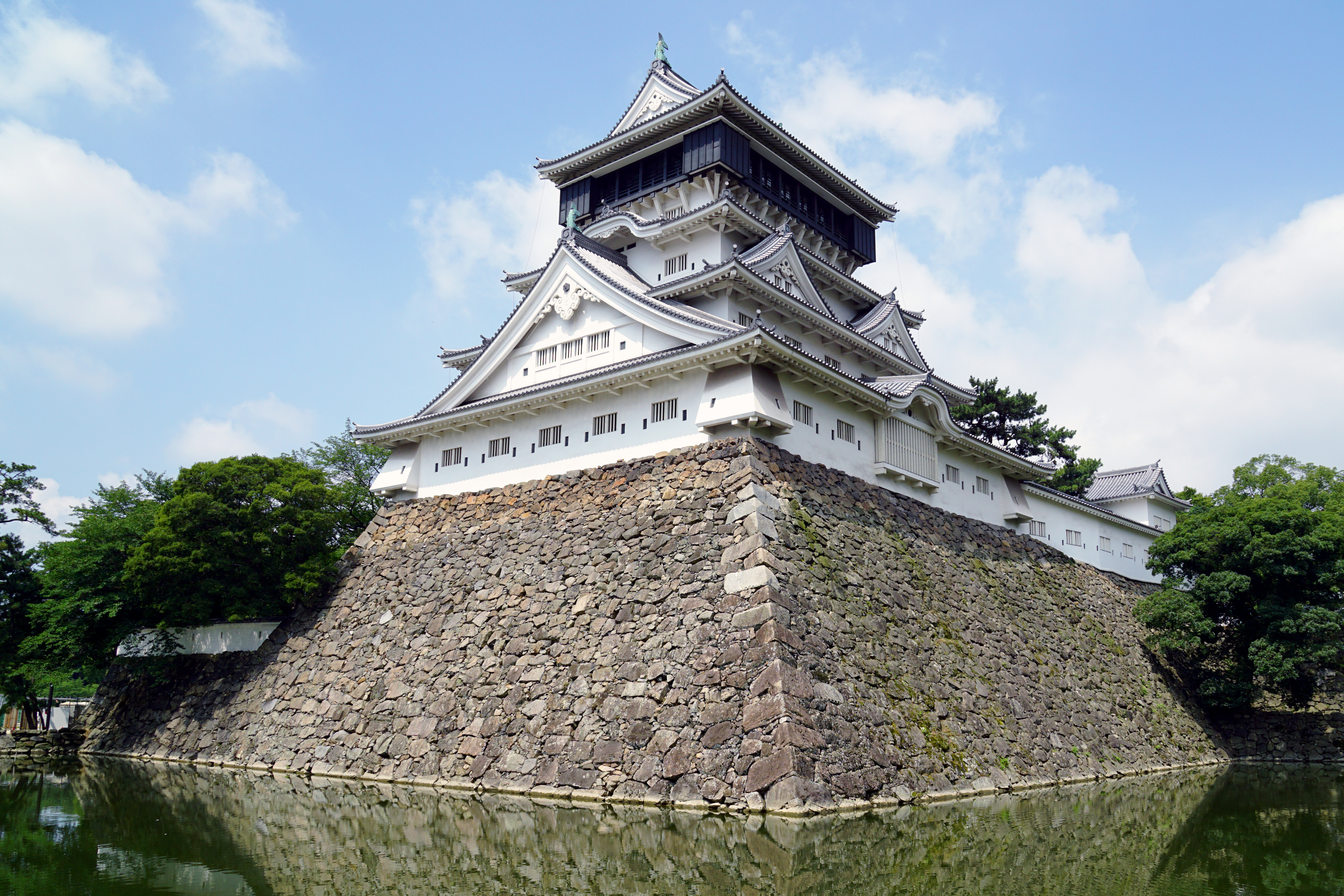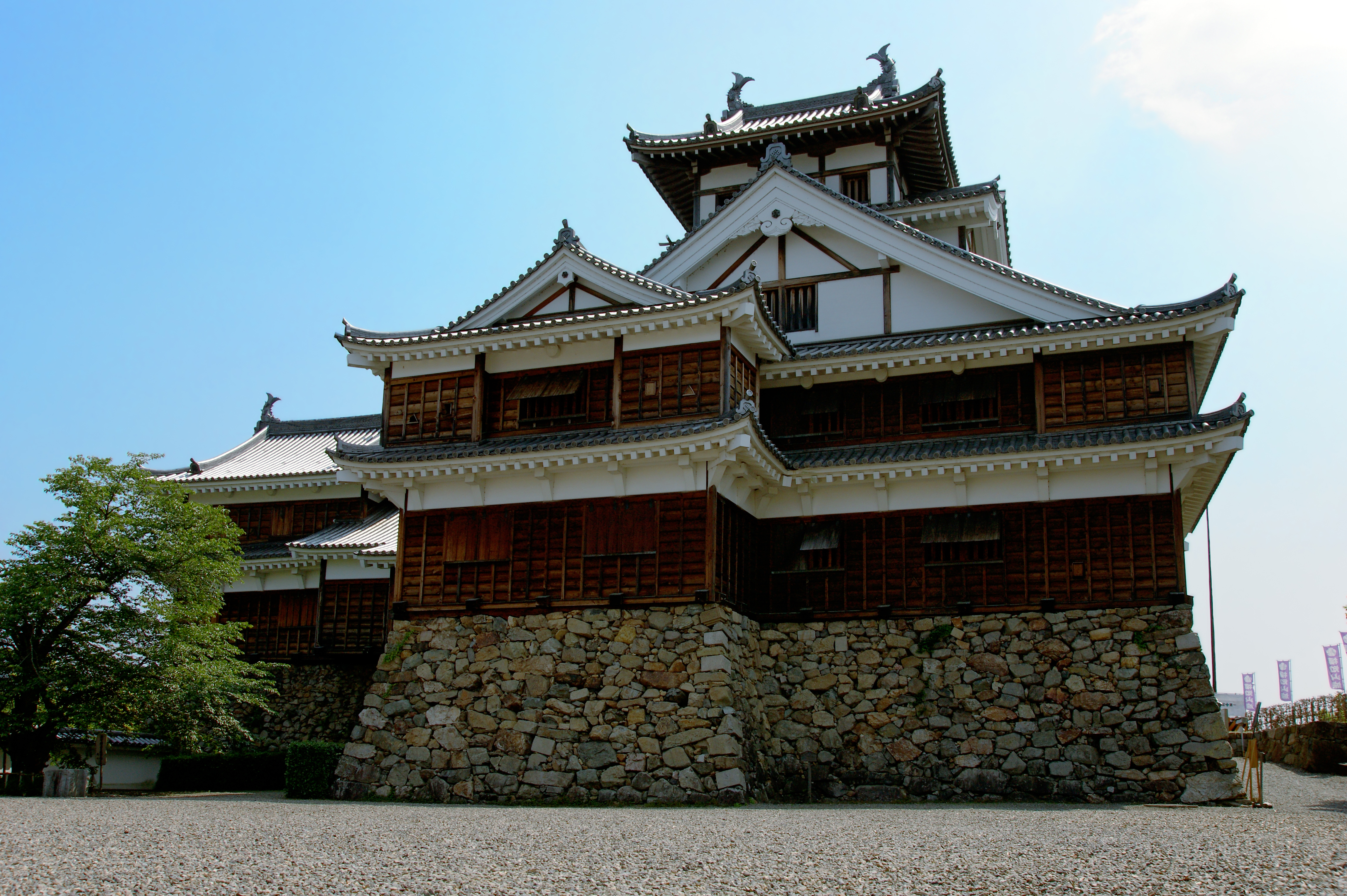|
Nakatsu Castle
is a Japanese castle in the city of Nakatsu in Ōita Prefecture. It is known as one of the three ''mizujiro'', or "castles on the sea", in Japan, with Takamatsu Castle in Kagawa Prefecture and Imabari Castle in Ehime Prefecture. History Construction began under the rule of Daimyō Kuroda Yoshitaka in 1587, when he was made the governor of the region by Toyotomi Hideyoshi for his help in the Kyūshū Campaign. Yoshitaka was rewarded with greater lands in Fukuoka after the Battle of Sekigahara and was replaced by Daimyō Hosokawa Tadaoki, who completed the construction. Tadaoki moved to Kokura Castle, when it was built, and Nakatsu castle was given to his son Hosokawa Tadatoshi. The castle was taken over by the Ogasawara clan and subsequently by the Okudaira Clan in 1717. It was abandoned in 1871 after the Meiji Restoration and the structure was destroyed in a fire during the Satsuma Rebellion in 1877. The present castle was built in 1964 by the descendants of the Okudaira sa ... [...More Info...] [...Related Items...] OR: [Wikipedia] [Google] [Baidu] |
Nakatsu, Ōita
is a Cities of Japan, city on the northern border of Ōita Prefecture in Kyushu, Japan. The city is on the border with Fukuoka Prefecture. Nakatsu was founded on April 20, 1929. As of March 2017, the city has an estimated population of 84,701 and a population density of 170 people per km2. The total area is 491.09 km2. History *1587: Kuroda Yoshitaka (Josui) built Nakatsu Castle as a flatland castle near the Yamaguni River. *April 1925: The village of Ōe was merged with Toyoda to become the town of Nakatsu. *April 1919: The village of Ogusu and the town of Nakatsu were merged to become the city of Nakatsu. *August 1933: The villages of Tsurui, Ōhata and Josui were merged into Nakatsu. *April 1951: The village of Miho was merged into Nakatsu. *October 1954: The village of Wada was merged into Nakatsu. *February 1955: The village of Imazu was merged into Nakatsu. *March, 2005: The towns of Hon'yabakei, Ōita, Hon'yabakei, Yabakei, Ōita, Yabakei and Yamakuni, Ōita, Yama ... [...More Info...] [...Related Items...] OR: [Wikipedia] [Google] [Baidu] |
Kokura Castle
is a castle in Kitakyushu, Japan. It was built by Hosokawa Tadaoki starting in 1602, with construction completed in 1608. History Construction of Kokura Castle began in 1602 and was completed in 1608. It was the property of the Ogasawara clan (from Harima) between 1632 and 1860. The castle burnt down from a fire in 1837, with parts of it rebuilt in 1839. The castle was burnt down intentionally in 1866 by retreating Kokura troops during its skirmish against the Chōshū clan during the Second Chōshū expedition. Mori Ōgai was based at the castle at the turn of the 20th century, when it was a military base. The keep was reconstructed in 1959, and the castle was fully restored in 1990. Matsumoto Seicho Memorial Museum and castle garden were opened in 1998. Location The castle is about a ten-minute walk from JR Kyushu's Kokura Station. The north side of the moat is next to the Riverwalk shopping complex (completed in 2003). Attractions The castle keep contains a modern f ... [...More Info...] [...Related Items...] OR: [Wikipedia] [Google] [Baidu] |
Kuroda Clan
Kuroda (written: lit. "black ricefield") is a Japanese surname. Notable people with the surname include: *, Japanese painter * Akinobu Kuroda 黒田 明伸, Japanese historian *Chris Kuroda, lighting designer and operator for the band Phish and Justin Bieber, among others *Emily Kuroda (born 1952), American actress *, Japanese actress *, governor of Bank of Japan and former president of Asian Development Bank *, Japanese-born English actress *, Japanese baseball player *, pen name of a Japanese manga artist *, Japanese painter *, Japanese far-left philosopher and social theorist *, famed strategist under Toyotomi Hideyoshi *, Samurai, son of Kuroda Kanbei *, Japanese politician and second Prime Minister of Japan *, Japanese haiku poet *, Japanese ornithologist *, Japanese writer *Paul Kuroda, (1917-2001), Japanese-American nuclear scientist *Robert T. Kuroda (1922–1944), American soldier Medal of Honor recipient *, linguist, inventor of the Kuroda normal form In formal language th ... [...More Info...] [...Related Items...] OR: [Wikipedia] [Google] [Baidu] |
Castles In Ōita Prefecture
A castle is a type of fortified structure built during the Middle Ages predominantly by the nobility or royalty and by military orders. Scholars debate the scope of the word ''castle'', but usually consider it to be the private fortified residence of a lord or noble. This is distinct from a palace, which is not fortified; from a fortress, which was not always a residence for royalty or nobility; from a ''pleasance'' which was a walled-in residence for nobility, but not adequately fortified; and from a fortified settlement, which was a public defence – though there are many similarities among these types of construction. Use of the term has varied over time and has also been applied to structures such as hill forts and 19th-20th century homes built to resemble castles. Over the approximately 900 years when genuine castles were built, they took on a great many forms with many different features, although some, such as curtain walls, arrowslits, and portcullises, were ... [...More Info...] [...Related Items...] OR: [Wikipedia] [Google] [Baidu] |
Continued Top 100 Japanese Castles
The is a list of 100 Japanese castle, castles, intended as a sequel of 100 Fine Castles of Japan. The castles were chosen for their significance in culture, history, and in their regions by the in 2017. Hokkaidō region Tōhoku region Kantō region Kōshin'etsu region Hokuriku region Tōkai region Kansai region Chūgoku region Shikoku region Kyūshū region Okinawa region See also *List of castles in Japan *List of National Treasures of Japan (castles) Notes External linksJapan Castle Foundation {{Continued Top 100 Japanese Castles 100 Fine Castles of Japan, * Lists of castles in Japan ... [...More Info...] [...Related Items...] OR: [Wikipedia] [Google] [Baidu] |
Saitama Prefecture
is a landlocked prefecture of Japan located in the Kantō region of Honshu. Saitama Prefecture has a population of 7,338,536 (1 January 2020) and has a geographic area of 3,797 km2 (1,466 sq mi). Saitama Prefecture borders Tochigi Prefecture and Gunma Prefecture to the north, Nagano Prefecture to the west, Yamanashi Prefecture to the southwest, Tokyo to the south, Chiba Prefecture to the southeast, and Ibaraki Prefecture to the northeast. Saitama is the capital and largest city of Saitama Prefecture, with other major cities including Kawaguchi, Kawagoe, and Tokorozawa. Saitama Prefecture is part of the Greater Tokyo Area, the most populous metropolitan area in the world, and many of its cities are described as bedroom communities and suburbs of Tokyo with many residents commuting into the city each day. History According to ''Sendai Kuji Hongi'' (''Kujiki''), Chichibu was one of 137 provinces during the reign of Emperor Sujin. Chichibu Province was in western Saitama. ... [...More Info...] [...Related Items...] OR: [Wikipedia] [Google] [Baidu] |
Rangaku
''Rangaku'' (Kyūjitai: /Shinjitai: , literally "Dutch learning", and by extension "Western learning") is a body of knowledge developed by Japan through its contacts with the Dutch enclave of Dejima, which allowed Japan to keep abreast of Western technology and medicine in the period when the country was closed to foreigners from 1641 to 1853 because of the Tokugawa shogunate's policy of national isolation (sakoku). Through Rangaku, some people in Japan learned many aspects of the scientific and technological revolution occurring in Europe at that time, helping the country build up the beginnings of a theoretical and technological scientific base, which helps to explain Japan's success in its radical and speedy modernization following the forced American opening of the country to foreign trade in 1854. History The Dutch traders at Dejima in Nagasaki were the only Europeans tolerated in Japan from 1639 until 1853 (the Dutch had a trading post in Hirado from 1609 till 1641 bef ... [...More Info...] [...Related Items...] OR: [Wikipedia] [Google] [Baidu] |
Seto Inland Sea
The , sometimes shortened to the Inland Sea, is the body of water separating Honshū, Shikoku, and Kyūshū, three of the four main islands of Japan. It serves as a waterway connecting the Pacific Ocean to the Sea of Japan. It connects to Osaka Bay and provides a sea transport link to industrial centers in the Kansai region, including Osaka and Kobe. Before the construction of the San'yō Main Line, it was the main transportation link between Kansai and Kyūshū. Yamaguchi Prefecture, Yamaguchi, Hiroshima Prefecture, Hiroshima, Okayama Prefecture, Okayama, Hyōgo Prefecture, Hyōgo, Osaka Prefecture, Osaka, Wakayama Prefecture, Wakayama, Kagawa Prefecture, Kagawa, Ehime Prefecture, Ehime, Tokushima Prefecture, Tokushima, Fukuoka Prefecture, Fukuoka, and Ōita Prefecture, Ōita prefectures have coastlines on the Seto Inland Sea; the cities of Hiroshima, Iwakuni, Takamatsu, Kagawa, Takamatsu, and Matsuyama, Ehime, Matsuyama are also located on it. The Setouchi Region, Setouchi re ... [...More Info...] [...Related Items...] OR: [Wikipedia] [Google] [Baidu] |
Hagi Castle
, also known as Shizuki Castle, was a Japanese castle located in Hagi, Yamaguchi Prefecture. Hagi Castle was built in 1604 at the beginning of the Edo period as the main castle of the Mōri clan, and served as the seat of the Chōshū Domain for over 250 years until 1863. Hagi Castle was demolished in 1874 shortly after the Meiji Restoration. Hagi Castle's former site has been designated a UNESCO World Heritage Site since July 2015. History Hagi Castle was constructed in 1604 by Mōri Terumoto, the head of the Mōri clan, as his new seat after defeat at the Battle of Sekigahara in 1600. The Mōri had ruled most of the Chūgoku region by the late Sengoku period, and Terumoto had recently constructed Hiroshima Castle from which to rule it. However, Terumoto had joined the western alliance against Tokugawa Ieyasu and subsequently lost most of his holdings, including Hiroshima Castle, and was forced west into the provinces of Suō and Nagato. Following the establishment of the ... [...More Info...] [...Related Items...] OR: [Wikipedia] [Google] [Baidu] |
Satsuma Rebellion
The Satsuma Rebellion, also known as the was a revolt of disaffected samurai against the new imperial government, nine years into the Meiji Era. Its name comes from the Satsuma Domain, which had been influential in the Restoration and became home to unemployed samurai after military reforms rendered their status obsolete. The rebellion lasted from January 29, 1877, until September of that year, when it was decisively crushed, and its leader, Saigō Takamori, was shot and mortally wounded. Saigō's rebellion was the last and most serious of a series of armed uprisings against the new government of the Empire of Japan, the predecessor state to modern Japan. The rebellion was very expensive for the government, which forced it to make numerous monetary reforms including leaving the gold standard. The conflict effectively ended the samurai class and ushered in modern warfare fought by conscript soldiers instead of military nobles. Background Although Satsuma had been one of the ... [...More Info...] [...Related Items...] OR: [Wikipedia] [Google] [Baidu] |




